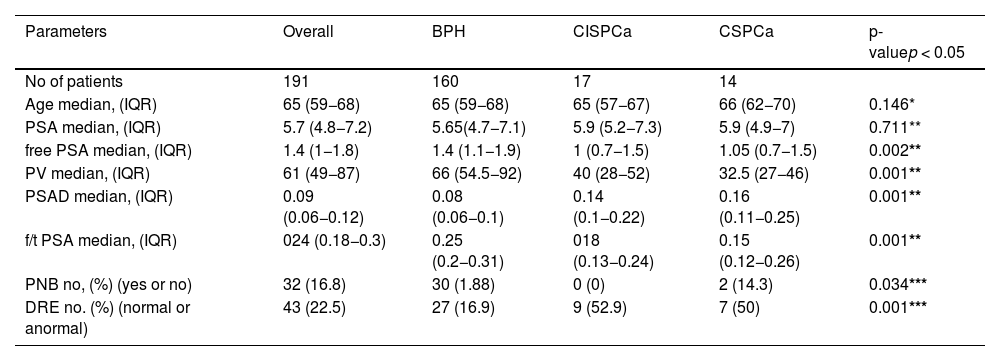To calculate the negative predictive value (NPV) of negative multiparametric prostate magnetic resonance imaging (mpMRI), accepted as no lesions on images, when combined with prostate-specific antigen density (PSAD) and free/total prostate-specific antigen ratio (f/t PSA) in grey zone patients.
Methods191 patients with PSA levels between 4−10 mg/mL and negative mpMRI were analyzed. The NPV of negative mpMRI was calculated according to a PSAD level of <0.15 ng/mL/mL, f/t PSA ratio of >0.15, and a combination of both. Patients were divided into three risk groups according to these two parameters, which were PSAD 0.01−0.07 ng/mL/mL and f/t PSA ratio ≥25 in a low-risk group, PSAD 0.08−0.15 ng/mL/mL, and f/t PSA ratio 0.15−0.24 in an intermediate-risk group and high-risk group, in which PSAD > 0.15 ng/mL/mL and f/t PSA ratio <15.
ResultsNPV of negative mpMRI was 92.6% for clinically significant prostate carcinoma (CSPCa). It increased to 97.5% in a low-risk group and decreased to 33.3% for CSPCa in a high-risk group. NPV of negative mpMRI results were so close when combined with PSAD < 0.15 ng/mL/mL and f/t PSA > 15.
Conclusionf/t PSA ratio might also be used to increase the NPV of mpMRI, like PSAD. We advise not to avoid prostate biopsy when PSAD is >0.15 ng/mL/mL and the f/t PSA ratio is <0.15. However, we need randomized controlled studies with more patients to confirm our study.
Calcular el valor predictivo negativo (VPN) de la resonancia magnética multiparamétrica (RMmp) de próstata negativa, definida como la ausencia de lesiones en las imágenes, cuando se combina con la densidad del PSA (DPSA) y el índice PSA libre/total (PSA l/t) en pacientes cuyo PSA se encuentra en la zona gris (4−10 mg/mL).
MétodosSe analizaron 191 pacientes con niveles de PSA entre 4 y 10 mg/mL y RMmp negativa. El VPN de la RMmp negativa se calculó de acuerdo con un nivel de DPSA < 0,15 ng/mL/mL, un índice PSA l/t > 0,15 y una combinación de ambos. Los pacientes se dividieron en tres grupos de riesgo según estos dos parámetros, de la siguiente manera: DPSA 0,01−0,07 ng/mL/mL e índice PSA l/t ≥ 25 en el grupo de bajo riesgo; DPSA 0,08−0,15 ng/mL/mL e índice PSA l/t 0,15−0,24 en el grupo de riesgo intermedio; DPSA > 0,15 ng/mL/mL e índice PSA l/t PSA < 15 en el grupo de riesgo alto.
ResultadosEl VPN de la RMmp negativa fue del 92,6% para el carcinoma de próstata clínicamente significativo (CPCS). El VPN aumentó a 97,5% en el grupo de riesgo bajo, y disminuyó a 33,3% en el de riesgo alto. El resultado al combinar la RMmp negativa con la DPSA < 0,15 ng/mL/mL fue muy similar al de su combinación con el PSA l/t > 15.
Conclusiónel índice PSA l/t también podría utilizarse para aumentar el VPN de la RMmp, al igual que la DPSA. No recomendamos evitar la biopsia de próstata con una DPSA > 0,15 ng/mL/mL y un índice PSA l/t < 0,15. Sin embargo, se requieren estudios controlados aleatorizados con más pacientes para confirmar los hallazgos de nuestro estudio.











